Sansevieria, also known as snake plant or mother-in-law's tongue, is a tropical plant native to West Africa. It is a hardy plant that can grow well in a variety of environments, making it an ideal choice for both indoor and outdoor cultivation.
Sansevieria is known for its attractive foliage and its air-purifying abilities, making it both beautiful and practical, and adding to its particular appeal as a houseplant. In this ultimate growing guide, we will explore everything you need to know about growing Sansevieria in Australia.
More...

Family: | Asparagaceae |
|---|---|
Genus: | Sansevieria |
Species: | Various |
Origin: | Africa and Asia |
Common Names: | Snake Plant |
Location: | indoor and outdoors |
Type: | Perennial foliage |
Growth: | Depends on the species |
Sun requirements: | bright indirect light |
Foliage Colour: | green with yellow or white stripes |
Flower Colour: | greenish-white or cream-coloured flowers on tall spikes (rarely flowers indoors) |
Flowering: | winter to early spring |
Edible Parts: | none |
Maintenance level: | Low |
Poisonous for pets: |
What is Sansevieria?
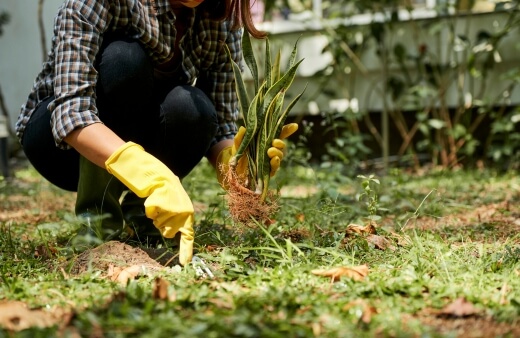
Sansevieria is a genus of perennial plants in the Asparagus family, Asparagaceae. Like everything in that family it shoots up from underground roots, which send out root-runners that create each new cluster of leaves.
They grow as rosettes, though in a more upright form to common rosettes, perhaps more akin to spider plants, which belong to the same family. Mother-in-Law’s Tongue is a low-maintenance plant that is known for its long, sword-shaped leaves that can grow up to 3 feet tall.
Sansevieria comes in a variety of leaf colours, patterns, and shapes, making them a popular choice for anyone decorating their homes and looking for structural interest.
Natural Habitat of Sansevieria
Sansevieria is native to tropical West Africa, from Nigeria to Congo. It is a hardy plant that can grow in a variety of environments, from arid deserts to rainforests.
It is a popular houseplant throughout the world which is why most of us love it, but it is also grown commercially for the production of fibre for ropes and baskets, continuing its traditional uses into the 21st century.
Sansevieria Reclassification
Sansevieria, the genus most commonly known as snake plants, was reclassified into the genus Dracaena in 2014. While reclassification is an essential part of botanical science, it is also a bit of a nightmare for plant collectors, gardeners, and houseplant enthusiasts.
In this particular case, Dracaena, known by most for their tall, thickened stems, turns out to be genetically close enough to Sansevieria, despite their lack of stem thickening. That stem thickening is caused by ‘secondary thickening meristems’, a type of plant tissue that transforms from once use into another, in this case, resulting in what is effectively bark.
For most gardeners, that is what defines a Dracaena, along with their spiked rosettes of foliage, giving them an appearance similar to a small palm tree. Sansevieria was previously a separate genus, and does not develop its secondary thickening meristem in the same way, leading to low growing rosettes of leaves.
However, through genetic testing, scientists using the APG III and APG IV classification system (based on DNA alone) confirms that they are the same genus.
I will forever call them sansevieria, because DNA does not necessarily relate to traits, because the Sansevieria species we have all become used to will always be significantly different in both how they are grown, and how they look, to the long, stiff-stemmed Dracaena, however they end up classified within the Dracaena genus (and it will likely evolve into subgenera classifications).
How to Grow Sansevieria in Australia
In all parts of Australia, Sansevieria is a hardy plant that can grow well both indoors and outdoors. While it is better known as a houseplant, and its native environment is more equatorial than our own, it is still very much possible to grow these stunning foliage plants outdoors in nearly all parts of Australia.
Growing Sansevieria Indoors
Sansevieria is an ideal indoor plant due to its low light requirements and air-purifying abilities, but it is actually quite easy to get wrong, particularly as a result of over-humidifying, over-watering, and over-caring.


Get Your Free Guide:
Master Growing Australian Natives eBook
A Must Have Complete Guide for Every Australian Garden
Get Your Free Guide:
Master Growing Australian Natives eBook
A Must Have Complete Guide for Every Australian Garden
Essentially, once a sansevieria is happy, it’s best left to its own devices.
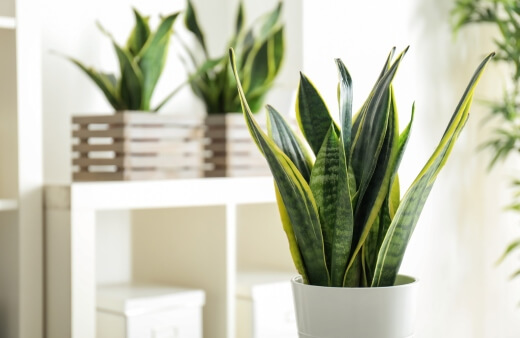
Light conditions
Sansevieria can tolerate low to bright indirect light. However, it is best to keep them in a bright location with indirect sunlight for best results. Avoid placing indoor sansevieria plants in direct sunlight as it can scorch the leaves, despite their native love of sunshine.
Soil
Sansevieria prefers well-drained soil that is rich in organic matter. A mix of well-rotted leaf mould or garden compost, mixed with perlite, and sand can be used to create a suitable soil mix, but you can buy good quality cactus and succulent mixes in most garden centres that can be used straight from the bag.
It’s also important to plant indoor sansevieria into a plastic container. You can drop that into a decorative planter if you like, but these plants have tough roots that will crack ceramic pots after 2-3 years.
How often to water Sansevieria
Sansevieria is a drought-tolerant plant that does not require frequent watering. Water the plant when the soil has completely dried out. Overwatering can cause root rot, so it is best to let the soil dry out between watering.
Temperature and humidity
Sansevieria can tolerate a range of temperatures, from 10°C to 30°C, which is fairly simple to achieve in almost any home, as long as it's not sat in a breezy spot over winter.
It also prefers a humidity level of around 30-40%, which is typical for most indoor environments. That means avoiding bathrooms and kitchens, or even unventilated bedrooms.
How to Grow Sansevieria Outdoors
Once established, sansevieria will generally live a longer and happier life if you can plant it outdoors. It doesn’t take much to get right either. By following the tips below, you’ll be able to get these architectural plants settled into your garden and should get to enjoy them for years and years to come.
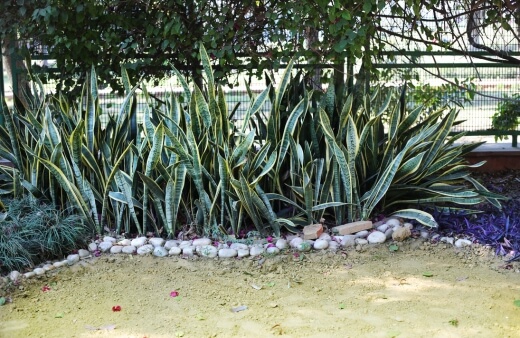
Soil & drainage
Sansevieria prefers well-draining soil that is rich in organic matter. For most Australian gardens, and even new builds, your typical garden soil will be reasonably well drained, but might require some organic matter to help feed these vigorous plants for the first few months.
Start by making sure the soil is moist but allows water to drain freely. If you're unsure, dig a square hole that is 1 ft wide and 1 ft deep, then fill it with water and let it drain away.
Once it’s drained, and the walls are moist to touch, re-fill the hole. It should drain completely in about 30 minutes. Any slower and you’ll need to dig in plenty of grit before planting sansevieria.
Location
Sansevieria can be grown in either full sun or part shade, but for outdoor plants, it’s best to place them in bright, direct light, with shade from the midday sun if possible. This will reduce how often you tend to water them, and for their first year, will protect their young leaves from sun scorch.
When to plant
Sansevieria can be planted outdoors in the spring or summer when the temperature is warm enough for growth. It is best to avoid planting them in winter as cold temperatures and wet weather can damage the plant.
Winter protection in cold climates
In colder climates, it's important to protect your plants from frost and freezing temperatures. If you plan to grow your sansevieria outdoors, consider planting it in a location that is sheltered from harsh winter winds.
You can also use a winter mulch to help insulate the soil and protect the roots. If you are growing Sansevieria indoors during the winter, make sure to keep the plants away from cold drafts and windowsills.
You can also provide some extra humidity by using a humidifier or placing a tray of water near the plants.
How to Propagate Sansevieria
Sansevieria plants are relatively easy to propagate, making it simple to create new plants from your existing specimens. There are two main methods for propagating sansevieria: from seed or from leaf cuttings.
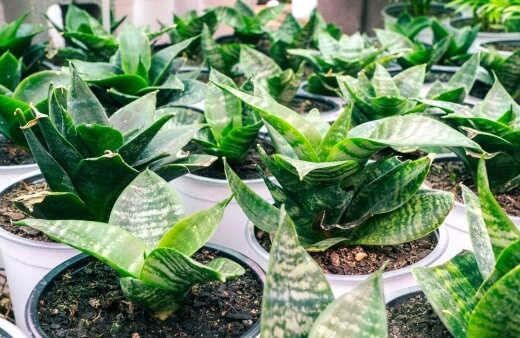
Propagating Sansevieria from Seed
While it is possible to propagate from seed, it can be a slow and challenging process. Sansevieria seeds are typically produced in the fall, and they require a warm, humid environment to germinate.
It can take up to two months for Sansevieria seeds to sprout, and the resulting plants may take several years to reach maturity.
- To propagate from seed, start by filling a seed tray with a well-draining potting mix.
- Moisten the soil and sprinkle the seeds evenly over the surface.
- Cover the seeds with a thin layer of vermiculite or sand to help retain moisture.
- Place the seed tray in a warm, humid location, such as inside a greenhouse or on a windowsill covered with plastic wrap.
- Keep the soil moist but not waterlogged, and be patient! It can take up to two months for the seeds to germinate.
- Once the seedlings have developed several leaves, they can be transplanted into individual pots and grown on until they are large enough to be planted outdoors or moved into larger pots.
Sansevieria Propagation from Cuttings
Propagating sansevieria from cuttings is a much faster and easier process than propagating from seed. Simply take a healthy leaf or leaf section from your existing plant and plant it in a pot filled with a well-draining potting mix, or even a glass of clean water (replaced every two days).
- Plant the leaf section with the cut end down and bury it about 2-3 cm deep in the soil.
- Water the soil and place the pot in a warm, bright location, but avoid direct sunlight.
- After a few weeks, roots should begin to form, and a new plant will start to grow.
- Once the new plant has developed several leaves, it can be transplanted into a larger pot or planted outdoors in a suitable location.
Caring for Sansevieria

Mulching
Mulching sansevieria is a great way to feed your plants, whether they’re indoors or outdoors, and it is as much about moisture retention and water reduction as it is about nutrients. Choosing the right mulch means finding the right balance, and it can change each year.
For example, if your sansevieria has used the nutrients in its soil, and the soil's structure has begun to crack or pull away from the side of the pot even after watering, it needs a nutrient-rich compost or soil improver.
Personally, I’d use leaf mould, rotted down, and sieved, for this, as it will re-invigorate the soil completely.
If the soil structure is fine, but you want to reduce watering without affecting drainage, add a fine layer of part-rotted bark mulch. This will trap moisture without doing anything to change nutrient levels.
For outdoor sansevieria, worms, and soil bacteria will work the mulch into the soil, but for indoor plants, you should scrape back the mulch layer once a year to avoid the buildup of excess organic material.
Repotting Sansevieria
Indoor sansevieria should be repotted every 2-3 years, or whenever the pot begins to bend under the pressure of its roots. Repotting can help to refresh the soil, provide the plant with more space to grow, and remove any damaged or dead roots.
To repot, gently remove the plant from its current container, being careful not to damage the roots. Inspect the roots for any signs of damage or rot and trim them if necessary.
Then, prepare a new container with fresh, well-draining soil, and place the plant in the new container, making sure to cover the roots with soil. Water the plant thoroughly after repotting.
What Fertiliser to Use
Sansevieria does not require frequent fertilisation, but adding fertiliser to the soil can help to promote healthy growth and improve the plant's overall appearance. It is recommended to fertilise sansevieria once every two months during the growing season, from spring to fall.
Choose a balanced fertiliser with an NPK ratio of about 20-20-20 (anything where nitrogen, potassium and phosphorus are in equal parts). Dilute the fertiliser according to the instructions on the packaging and apply it to the soil. Avoid getting the fertiliser on the plant's leaves, as this can burn them.
Sansevieria Species and Cultivars to Grow in Australia
Sansevieria, also known as the snake plant or mother-in-law's tongue, is a highly diverse genus with over 70 species and numerous cultivars.
Sansevieria aubrytiana
A larger species group of Sansevieria that is becoming more popular is the tough-leaved aubrytiana types. The base of the species has deep dotted variegations, and upright rosettes.
- Sansevieria aubrytiana ’Jade’ - While the true variegations of the S. aubrytiana shine through in this cultivar, ‘Jade’ offer much deeper, cleaner leaf colour, with more shine, and looks stunning in a bathroom, or even an outdoor kitchen.
Sansevieria bacularis
This Sansevieria has long, thin leaves that grow in a cylindrical shape. The leaves are dark green with white stripes. It's a slow-growing plant that can reach up to 3 feet tall. It's a great choice for those who want a snake plant with a distinct shape.
Sansevieria canaliculata
S. canaliculata is a cylindrically leaved variety, but is an entirely distinct species from S. cylindrical. The finer, and looser leaves tend to rot quickly if overwatered, but in good conditions it can reach several feet tall.
Sansevieria cylindrica
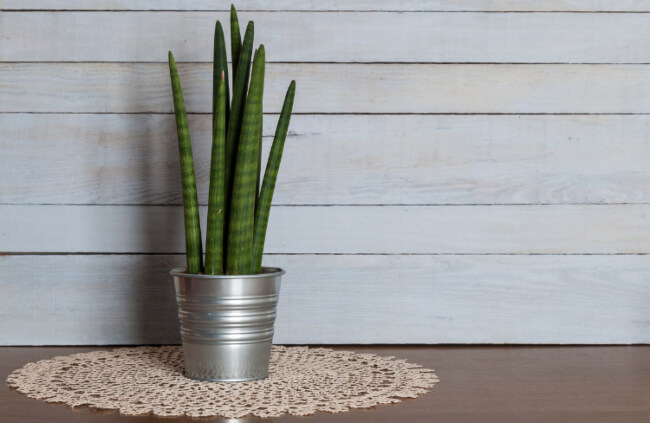
Sansevieria cylindrica
Also known as the African spear plant, this species has long, cylindrical leaves that are green with a pointed tip.
- Sansevieria cylindrica ‘Boncel’ - Also known as Sansevieria ‘Starfish’, is a stunning cultivar with leaves that grow in a star-like pattern, dramatically fanning out and retaining a compact form right to maturity, giving it its name. Its leaves are thick and fleshy, with green and white stripes.
- Sansevieria cylindrica ‘Boncel Rhino’ - This cultivar of S. cylindrica has thick tubular leaves that grow in a distinct fan pattern and can reach up to 3 feet in height. The leaves are pale green with darker green stripes. It gets its name from the fact cuttings are slow to take, and look like a rhino horn until they develop.
- Sansevieria cylindrica ‘Fan’ - This plant has fan-shaped leaves that grow upright and can reach up to 2 feet in height. The leaves are light green with darker green horizontal stripes.
- Sansevieria cylindrica ‘Skyline’ - While Sansevieria ‘Skyline’ is similar to most S. cylindrica cultivars, its slender leaves make for a more dramatic silhouette. It’s easy to care for and slow growing, so can be placed in any bright spot and watered intuitively.
- Sansevieria cylindrica ‘Twist’ - This cultivar has twisted, cylindrical leaves that grow upright and can reach up to 3 feet in height. The leaves are a light green colour with darker green stripes.
Sansevieria ehrenbergii
This species features stiff, upright leaves that are green with a mottled pattern.
Sansevieria francisii
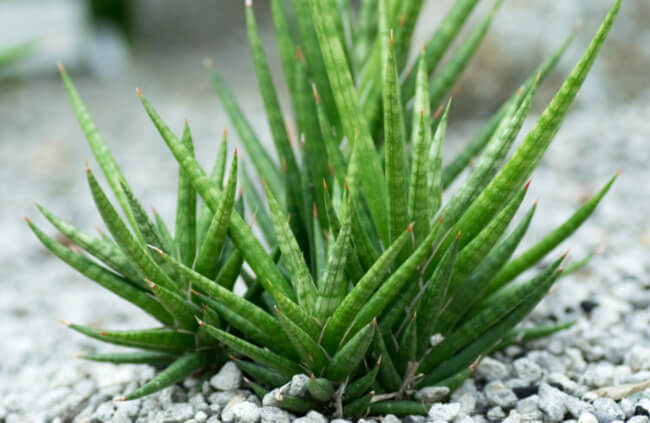
Sansevieria francisii
This species has narrow, cylindrical leaves that are light green with dark green markings.
Sansevieria gracilis
A gorgeous species with leaves that grow in a rosette shape. Its leaves are thin and cylindrical, with white and green stripes. It is native to Kenya and Tanzania.
Sansevieria guineensis ‘Beauty Queen’
The sheer white swathes across each leaf of Sansevieria ‘Beauty Queen’ are completely unique. When young, or from cuttings, the foliage is so white that any hint of green stands out like a sore thumb, but as these plants develop they even out into a gorgeously pale rosette at around 2 ft tall.
Sansevieria kirkii
S. kkirkii has quite flat, inwardly curved dark green leaves with silver edges, and a sharply pointed tip, giving it a striking appearance. It is also very slow growing, making it ideal for small spaces.
- Sansevieria kirkii ‘Blue Star’ - A hybrid cultivar with long, narrow leaves that are bluish-green in colour. Its striking foliage and upright growth habit make it a great choice for statement pieces.
- Sansevieria kirkii ‘Coppertone’ - A hybrid cultivar with green leaves that have a copper-coloured tint. Its deep, metallic colouration and upright growth habit make it a great choice for statement pieces.
- Sansevieria kirkii ‘Silver Blue’ - A hybrid cultivar with silvery-blue leaves that have a striking pattern of dark green stripes. It's delicate colouration and attractive foliage make it a popular choice for indoor gardens.
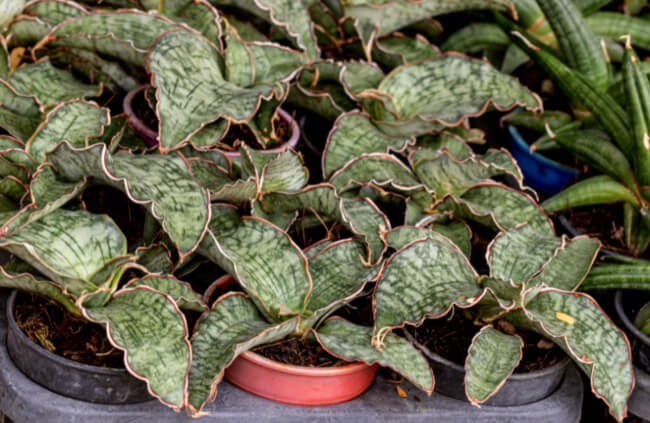
Sansevieria ‘Kirkii Silver Blue’
- Sansevieria kirkii ‘Pulchra’ - A hybrid cultivar with glossy, dark green leaves that have a striking pattern of lighter green stripes. Its wide and unusual foliage and attractive appearance make it a popular choice for indoor gardens.
Sansevieria masoniana
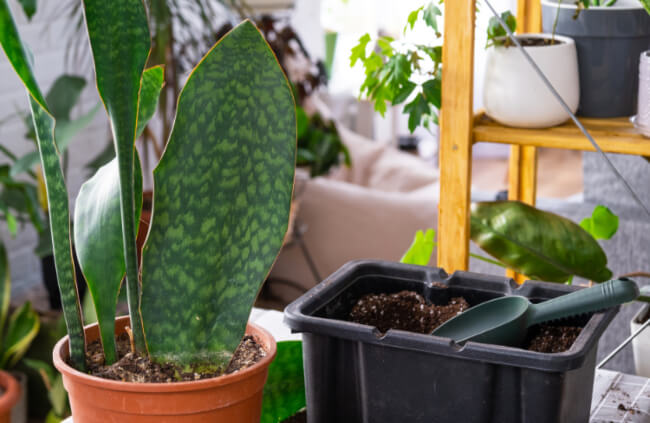
Sansevieria masoniana
This species features large, paddle-shaped leaves that are green with a mottled pattern. It is a slow grower but can reach a height of about 3-4 feet with proper care.
- Sansevieria masoniana (Mason’s Congo) - Mason’s Congo has long, cylindrical leaves that grow upright and can reach up to 7 feet in height. The leaves are dark green and have a smooth texture.
Sansevieria patens
A rare and slow-growing species that is highly sought after by collectors. It has long, narrow leaves that are heavily mottled with silver-grey markings. It is native to Tanzania.
Sansevieria parva
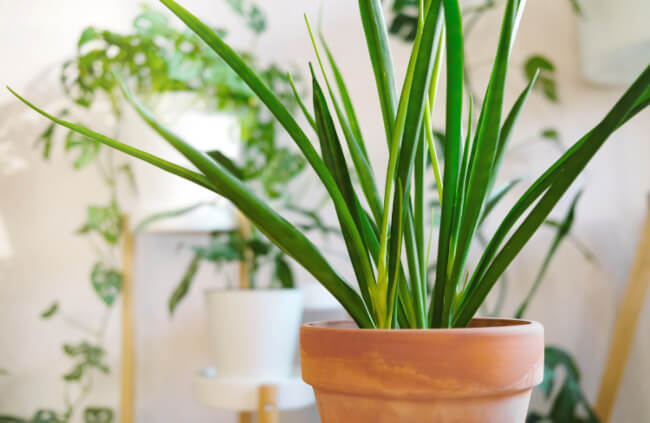
Sansevieria parva
A small, compact species that is perfect for smaller spaces. Its leaves are narrow and pointed, with pale green and silver markings. It is native to Kenya and Tanzania.
Sansevieria pinguicula
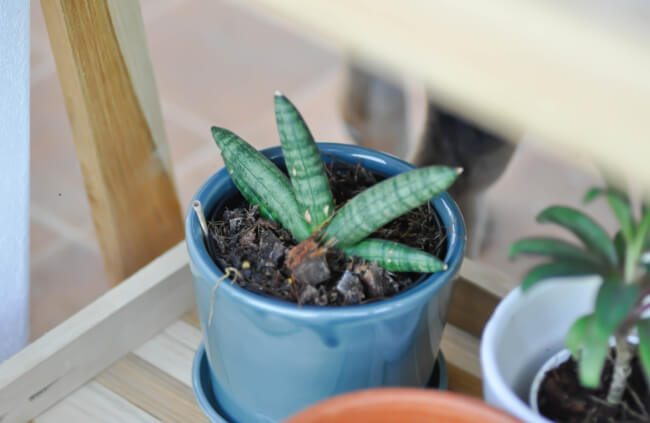
Sansevieria pinguicula
Also known as the "Walking Sansevieria", this species produces new shoots at the base of its leaves, which eventually grow roots and detach from the parent plant, allowing it to spread over time. Its leaves are thick and glossy, with green and yellow stripes.
Sansevieria raffillii
A species that features long, narrow leaves with a grey-green colour and a pointed tip. It is a slow grower but can reach a height of about 3-4 feet with proper care.
Sansevieria trifasciata

Sansevieria trifasciata
Probably the most common of all snake plants is Sansevieria trifasciata, which is the breeding base for most upright Sansevieria species. Though technically reclassified as a Dracaena, it requires the same treatment as the other Snake Plants in this list.
- Sansevieria trifasciata ‘Bantel’s Sensation’ - A striking cultivar that features long, narrow leaves with white vertical stripes on a dark green background. It is a slow grower but can reach a height of about 2-3 feet with proper care.
- Sansevieria trifasciata ‘Black Coral’ - A cultivar with thick, succulent leaves that are deeply shrouded in the darkest greens, with gently stripes of pale, pastel greens running horizontally across each upright leaf. It's a low-maintenance plant that is easy to care for. It grows slowly but can reach up to 4 feet tall.
- Sansevieria trifasciata ‘Black Dragon’ - This variety has dark green leaves with intense shine to them. At their tips, they show signs of recognisable sansevieria variegations, but for most of the leaf, it’s a matt emerald green. The leaves are arranged in a rosette shape and can grow up to 3 feet in height.
- Sansevieria trifasciata ‘Black Gold’ - A beautiful cultivar with dark green leaves that are accented with golden stripes. It is a slow grower but can reach a height of about 3 feet with proper care.
- Sansevieria trifasciata ‘Black Robusta’ - This is a dark-coloured variety with wide, cylindrical leaves that grow upright. The leaves are deep green and can grow up to 4 feet tall.
- Sansevieria trifasciata ‘Futura’ - This variety has cylindrical leaves that grow upright and can reach up to 3 feet in height. The leaves are a light green colour with darker green stripes.
- Sansevieria trifasciata ‘Futura Robusta’ - A cultivar with wide, dark green leaves that have a slight twist at the tip. It's a slow-growing plant that can reach up to 3 feet tall. It's a great choice for those who want a striking plant with a modern look.
- Sansevieria trifasciata ‘Futura Superba’ - A hybrid cultivar with long, narrow leaves that are dark green in colour with a mottled centre, and crisp creamy borders. Its classic foliage and upright growth habit make it a great choice for statement pieces.
- Sansevieria trifasciata ‘Gold Dust’ - A variety with golden yellow edges to distinctly chalky green leaves. It's a striking plant that makes a great addition to any collection. It grows slowly but can reach up to 3 feet tall.
- Sansevieria trifasciata ‘Golden Flame’ - This cultivar has wide, flat leaves that grow upright and can reach up to 2 feet in height. The leaves are a light green colour with yellow margins.
- Sansevieria trifasciata ‘Golden Hahnii’ - A dwarf cultivar that has short, rosette-shaped leaves that are yellow-green in colour. It is perfect for small spaces and can be used as a tabletop plant.
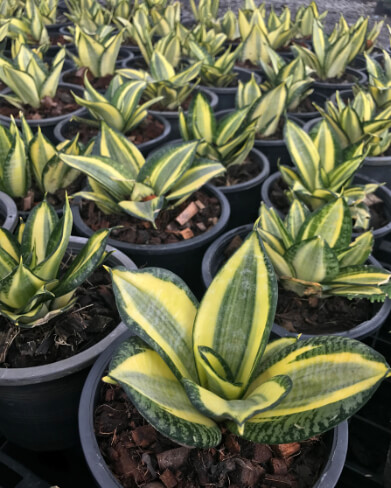
Sansevieria trifasciata ‘Golden Hahnii’
- Sansevieria trifasciata ‘Hahnii’ - A popular species with a rosette shape, it is commonly known as the "Bird's Nest Sansevieria". Its leaves are short and stubby, with a variety of colours including green, silver, and bronze.
- Sansevieria trifasciata ‘Hahnii Golden Wendy’ - A compact cultivar with green and creamy-golden variegated leaves. It's small size and attractive foliage makes it a popular choice for desktops or shelves, but its twisted, rotating habit that sets it apart.
- Sansevieria trifasciata ‘Hahnii Green’ - A hybrid cultivar with dark green leaves that form a tight rosette. It's compact size and attractive foliage make it a great choice for small spaces.
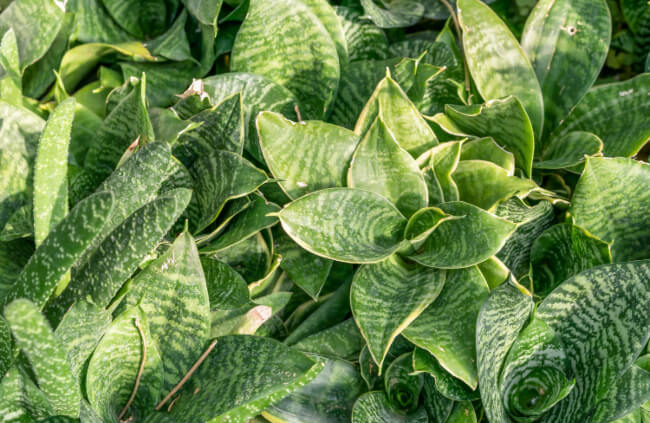
Sansevieria trifasciata ‘Hahnii Green’
- Sansevieria trifasciata ‘Hahnii Jade’ - A small hybrid cultivar with jade green leaves that form a tight rosette. Its compact size makes it a great choice for tabletops or terrariums.
- Sansevieria trifasciata ‘Hahnii Silver Frost’ - This cultivar has striking, silvery-green leaves with a frosty appearance. It's compact size and bold colouration makes it a popular choice for indoor gardens.
- Sansevieria trifasciata ‘Hahnii Tricolour’ - A hybrid cultivar with variegated leaves in shades of green, cream, and yellow. Its compact size and crisp, striped, colouration make it a great choice for small spaces or mixed planters.
- Sansevieria trifasciata ‘Jiboia’ - Also known as Brazilian bowstring hemp, this cultivar has long, slender leaves with a green and yellow marbled pattern. It is a popular choice for hanging baskets or tall planters.
- Sansevieria trifasciata ‘Jiboia Compacta’ - A compact version of the Jiboia cultivar, with shorter leaves and a more upright growth habit. Its structural foliage and small size make it a great choice for small spaces.
- Sansevieria trifasciata ‘Jiboia Variegated’ - A variegated cultivar of the ‘Jiboia’, with green and cream-striped leaves. Its stunning foliage and striking colouration make it a popular choice for indoor gardens.
- Sansevieria trifasciata ‘Laurentii’ - Also known as the snake plant, this popular cultivar features tall, erect leaves with yellow margins that contrast with the dark green centre. It is a low-maintenance plant that is perfect for beginners and can survive in low-light conditions.
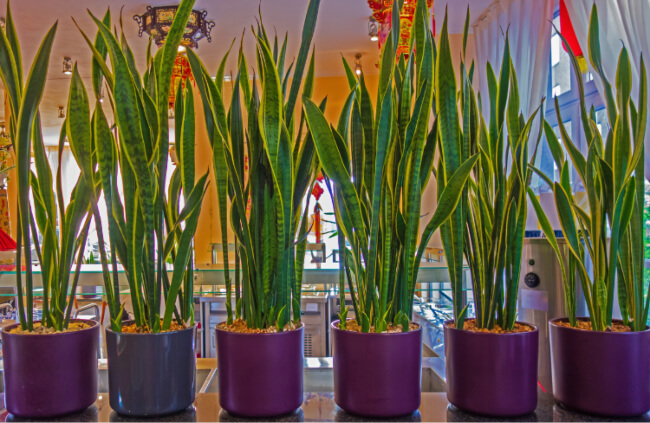
Sansevieria trifasciata ‘Laurentii’
- Sansevieria trifasciata ‘Laurentii Superba’ - This variety is a larger version of the Sansevieria trifasciata ‘Laurentii’. It has long, wide leaves that are dark green with yellow margins. The leaves can grow up to 4 feet tall.
- Sansevieria trifasciata ‘Metallica’ - Sansevieria ‘Metallica’ has tall, narrow leaves that are a pale, dusty green, and grows up to 3 feet tall. With each leaf looking stretched into position, that’s a structural beauty, but also an unusual interest to this variety.
- Sansevieria trifasciata ‘Moonshine’ - A popular cultivar with silvery-blue leaves. Sansevieria ‘Moonshine’ is a low-maintenance plant that is easy to care for. It grows slowly but can reach up to 3 feet tall. It's a great choice for those who want a less in-your-face plant with a modern look.

Sansevieria trifasciata ‘Moonshine’
- Sansevieria trifasciata ‘Night Owl’ - A variety with dark green leaves that have a subtle silver-grey sheen. It's a slow-growing plant that can reach up to 2 feet tall. It's a great choice for those who want a snake plant with a delicate matt colouration.
- Sansevieria trifasciata ‘Robusta’ - This is a large variety with wide, cylindrical leaves that grow upright. The leaves are a deep green colour and can grow up to 4 feet tall.
- Sansevieria trifasciata ‘Silver Princess’ - A snake plant with silver-grey variegation on its leaves. It has a compact growth habit and is easy to care for. It's a great choice for those who want a unique, low-maintenance plant.
- Sansevieria trifasciata ‘Silver Queen’ - A variety with wide, silver-grey leaves that grow in a rosette. It's a slow-growing plant that can reach up to 3 feet tall. It's a great choice for those who want a striking plant with a modern look.
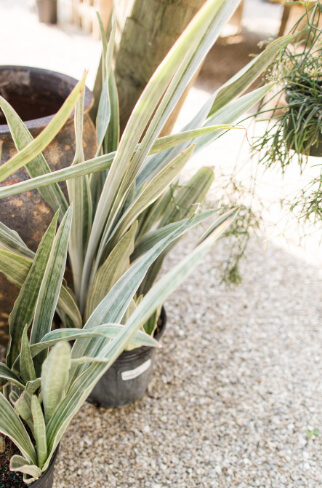
Sansevieria trifasciata ‘Silver Queen’
- Sansevieria trifasciata ‘Twisted Sister’ - A cultivar with leaves that grow in a twisted shape, giving it its name. Its leaves are long and narrow, with green and silver markings.
- Sansevieria trifasciata ‘Whitney’ - This cultivar has dark green leaves with white margins that give it a striking appearance.
Sansevieria zeylanica
A species that features long, sword-shaped leaves that are dark green with lighter green stripes.
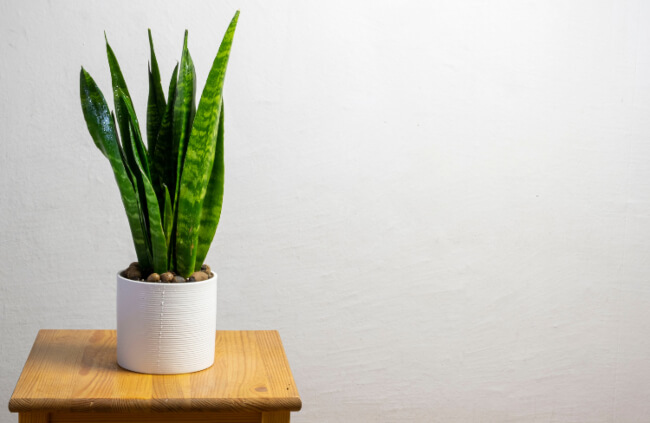
Sansevieria zeylanica
Sansevieria ‘Almond Silver’
The clear layering of the cupped and pointed leaves of Sansevieria ‘Almond Silver’ is enough to clearly define it from all others. But if you still need convincing, check out the beautiful red leaf borders which perfectly set off the silvery-green foliage.
Sansevieria ‘Black Jade’
A hybridised version of ‘Black Hahnii’ and S. trifasciata (though sold as both) is Sansevieria ‘Black Jade’. Its compact rosette looks almost like a bromeliad while young, but it quickly begin to shoot upwards, producing a unique dark leaved cluster.
Sansevieria ‘Cleopatra’
This cultivar has wide, flat leaves that grow upright and can reach up to 3 feet in height. The leaves are light green with darker green stripes.
Sansevieria ‘Congo Blue’
This variety has long, cylindrical leaves that grow upright and can reach up to 3 feet in height. The leaves are a deep green colour with a blue tint.
Sansevieria ‘Malawi Midnight’
This variety has rugged, wavy leaves that form in a loose rosette. Its variegations are evenly dotted across the leaves, rather than forming distinct strips. It thrives in well drained composts.
Sansevieria ‘Malawi Bat’
Unlike ‘Malawi Midnight’, ‘Malawi Bat’ is more neatly arranged, typically in rosettes with three leaves to a layer. Leaf rims can be pale white or pink, but are distinctly rippled.
Sansevieria ‘Mikado’
A slow-growing snake plant with narrow, pointed leaves that grow upright from the base. The leaves are dark green with light green spots and have a slight twist at the tip. It's a low-maintenance plant that is easy to care for.
Sansevieria ‘Fernwood Mikado’
A compact cultivar with narrow, upright leaves that are darker than those of ‘Mikado’. It has a bushy growth habit and can be propagated easily. It's a good choice for those who want a smaller snake plant.
Sansevieria ‘Fernwood Punk’
A rare cultivar with subtle striped variegation on its leaves. Nearly identical to ‘Mikado Fernwood’, but with unruly twisting stems that add a distinct and cheerful character. It's a slow-growing plant that can reach up to 3 feet tall. It's a great choice for collectors who want a dazzling snake plant.
Sansevieria ‘Spearpoint’
This variety has long, pointed leaves that grow upright. The leaves are a vibrant green with light green horizontal stripes.
Sansevieria ‘Yellowstone’
This variety has leaves that are a bright green colour with light green variegation. The leaves are arranged in a rosette shape and can grow up to 3 feet tall. The edges of the leaves have a yellow tint to them.
Common Sansevieria Problems
Sansevieria is a relatively pest and disease-resistant plant, but it can still be susceptible to a few common problems.
Sansevieria Pests
Spider mites and mealybugs are the most common pests that can affect sansevieria. These pests can cause yellowing or browning of the leaves and a sticky residue on the plant's surface.
To treat spider mites or mealybugs, first, isolate the affected plant from other plants to prevent the infestation from spreading. Then, wash the plant with a gentle soap solution or spray with insecticidal soap.
Repeat the treatment every one or two weeks until the pests are gone. Refer to our guide for more on how to get rid of spider mites and prevent them from coming back.
Sansevieria Diseases
Sansevieria can be susceptible to root rot if the soil is too wet, and the roots are not allowed to dry out between watering. Symptoms of root rot include yellowing or wilting of the leaves and a foul smell coming from the soil.
To treat root rot, first, remove the plant from the soil and inspect the roots for any signs of damage or rot. Trim away any damaged or rotting roots and repot the plant in fresh, well-draining soil. Allow the soil to dry out between watering to prevent the problem from recurring.
Sansevieria Frequently Asked Questions
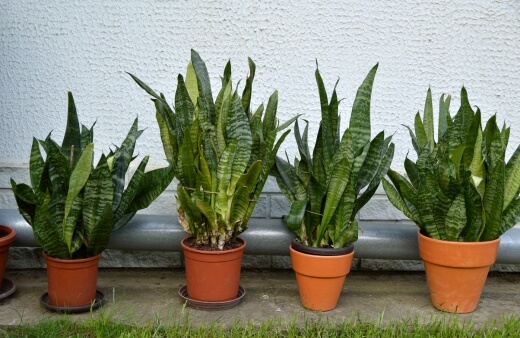
Can I grow Sansevieria in water?
Sansevieria can be grown in water. However, it's important to use distilled water or rainwater instead of tap water, which can contain chemicals that are harmful to the plant. Change the water every two weeks to prevent bacteria from growing.
How often should I fertilise Sansevieria?
Sansevieria plants do not require frequent fertilisation, and over-fertilisation can harm the plant. A slow-release fertiliser applied once a year during the growing season is sufficient. Alternatively, you can fertilise with a diluted liquid fertiliser every 2-3 months.
Can Sansevieria grow in low light?
Sansevieria can tolerate low light conditions, but it will grow more slowly and may not produce as many leaves. However, for more vigorous and reliable growth, place Sansevieria in bright, indirect light.
How often should I water Sansevieria?
Sansevieria is a drought-tolerant plant, so it doesn't require frequent watering. Allow the soil to dry out completely between waterings, and be sure not to overwater as it can cause root rot.
Start Growing Sansevieria to Add Greenery to Your Living Space
Sansevieria is a versatile and low-maintenance plant that can be grown just as well outdoors and indoors in Australia. With its attractive foliage and air-purifying qualities, it is a popular choice for those who want to add some greenery to their living space.
Whether you are growing sansevieria for the first time or are a confident gardener, the tips and information provided in this guide will help you to grow healthy, happy, sansevierias for years to come.
From selecting the right variety and location to proper watering and fertilisation, taking care of sansevieria is easy and rewarding.
Published on June 5, 2023 by Maisie Blevins
Last Updated on October 1, 2025




